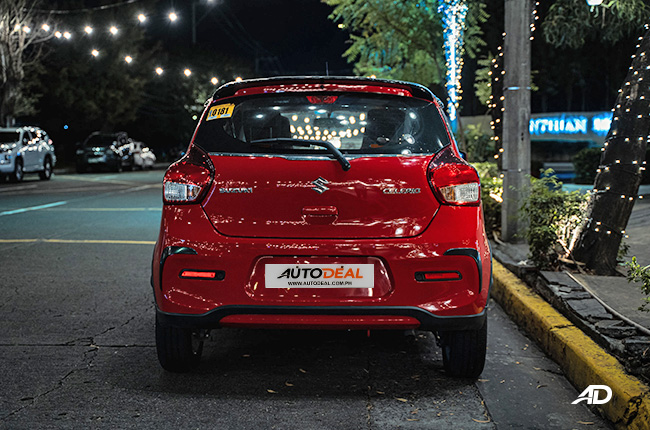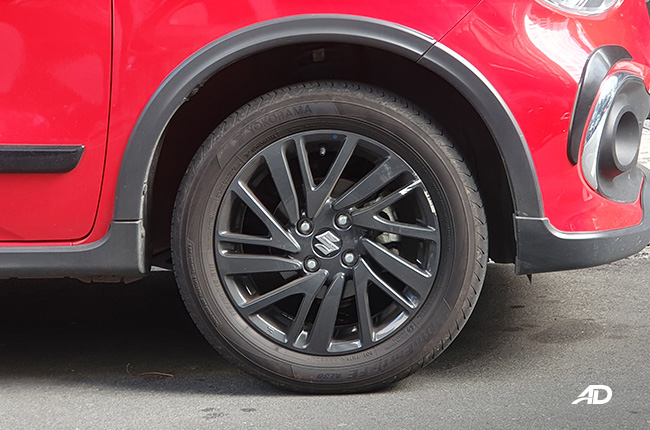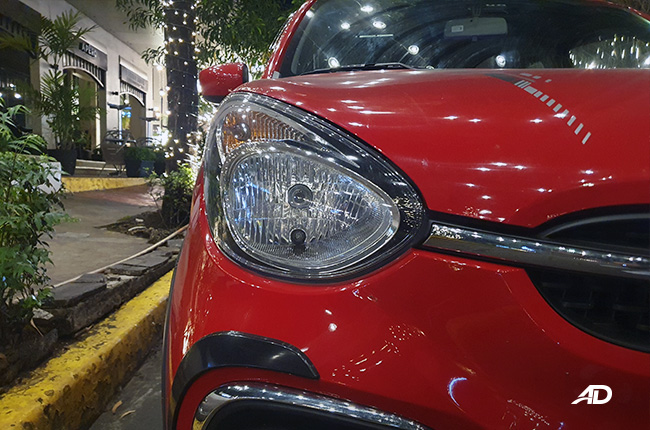
We’re all spoiled for choice in the Philippines when it comes to small cars. There are a wealth of options out there in the Philippine market. It’s a competitive world out there when you’re a brand making a small car because some of the biggest names in the industry have their hat in the ring.
Brands like Honda and Toyota have found success in the small hatchback segment, and Suzuki’s also got a knack for making small cars as well so how will their model stack up? Let’s find out in this review.
Engine Output (HP), Acceleration, Transmission, Handling 3.0/5
Exterior & Interior Design, Quality, Fit and Finish, Ergonomics 3.5/5
Cabin Comfort, Suspension, NVH Insulation 3.0/5
Convenience Technologies, Active and Passive Safety Features 3.5/5
Amount of the vehicle you get for the price, Fuel Efficiency 3.0/5
- Extremely frugal gasoline engine
- Surprisingly behaved on the highway
- NVH insulation is better than acceptable
- The AGS transmission is a miss
- The engine struggles at high speeds
- The infotainment system is outdated for a top-of-the-line offering
- A little pricey for what it is
Exterior
In a world where the Honda Brio exists, the Suzuki Celerio looks a little plain. Believe us, the brand looks like it tried with its little hatch putting some decals, fitting black wheels on, and even giving us the red test unit so it stands out more. If you’re familiar with the new Celerio, you will know that the old model had little to no flair in its design, so in that respect, it’s a definite upgrade. In the grand scheme of things, however, it’s a bit of an acquired taste. Its rivals look bigger and sportier so it’s a bit of a hard sell if looks were your top priority.
Even so, the grille looks decent, and the lower section of the bumper does well to make the car look bigger than it actually is, but the rear is plain, and there are no LED lights on this car so there’s not much wow factor. Perhaps the blacked-out 15-inch wheels are an interesting choice for the model, but again, it’s pretty plain. A plus side to the Celerio, however, is its ample ground clearance. With 145 mm, it’s pretty tall for a small car. Other sedans would have you sitting at about 130 mm so you’re pretty safe from scraping the bottom of the Celerio on most speedbumps and potholes in the city.
Functionally speaking, the car just works as it should. We found the lights to be more than adequate, perhaps one of the better halogen setups in the class. LEDs would have been appreciated based on this car’s price point, but more on that later. Overall, it’s just a basic small hatch. The Celerio’s not groundbreaking, but it’s certainly an improvement over the old model. With all due respect, however, it’s a plain car. Certainly, the Celerio will have some fans out there, but to us, it’s eclipsed by its other rivals in the class.
Interior

Suzuki made a big deal out of the Celerio’s interior, stating that the brand has made some changes to make it seem bigger. In order to do so, there had to be some compromises with regard to the door cards. The front seats are big enough to fit large individuals, but not comfortably so. If you find yourself on the wider side of the spectrum, you could find the Celerio a bit cramped with your legs hitting the sides of the gear lever, and a bit on the door cards. However, for more average build individuals, the Celerio is plenty adequate. The rear is also interesting as there is enough space for people that are up to six feet tall and the side-to-side space is pretty decent with four passengers. Trying to fit five people in the Celerio will be hard given how narrow its cabin is, so best to stick to four if you want everyone to have a nice journey.
The quality of the cabin is signature Suzuki. The plastic quality on the dashboard, air conditioning vents, and even the door cards was pretty solid for a car in this class. There were little to no creaks in the vehicle even if we really tried to induce some form of flex. Props to Suzuki for making their plastics sturdy. Though, we won’t say that the Suzuki has a marvelous interior based on the feel of the plastics alone. Most of the other touchpoints in the car are decidedly budget-feeling which includes the tilt-only adjustable steering wheel, the AC controls, and the other switches in the car. The only other tactily-pleasant part of the Celerio was the gear lever, which was actually quite fun to play with when you were using it in manual mode if we’re being honest.

Hauling items with the Celerio will surprise you a bit. At first glance, we were impressed at how deep the space was behind the rear seats. You can also fold the rear in order to get more space in the car for stuff like a wheelchair and maybe a week’s supply of groceries. With 254 liters of space at the back, it’s a decent hauler for stuff, but the lip is rather distracting if you wish to put heavier items in.
Comfort

The Celerio is built on a unibody chassis which Suzuki calls its HEARTECT platform. The suspension in the front is a MacPherson strut with a torsion beam at the rear, but the ride is decidedly not as good as its other rivals. While the roads were smooth, the ride was comfortable even for passengers at the back. However, the Celerio starts to show its flaws once it hits well-traversed thoroughfares like EDSA or C5 in Metro Manila. The suspension is underdamped, so we were getting quite a bit of vibration from the chassis while going over bumps. It’s a little confusing how weird the ride felt since it was similar to how SUV and ladder-frame MPVs feel.
Still, it’s not all bad. We’re quite satisfied with how manageable the wind and tire noise was whether at high or low speeds. While the exterior may not look super aesthetically pleasing, it gets the job done as the Celerio was able to cut through the air silently enough at 100 km/h. Even the engine wasn’t too intrusive while it was under load on the highway, so while its chassis needs work, noise was kept to a decent minimum.
Technology

We all like to think that more is better, but focusing on putting specs on a piece of paper may lead to some unforeseen consequences. The Celerio has some features that none of its rivals have but at the cost of refinements and focus. That being said, the technology package in the Celerio is a bit of a mixed bag. Most of the things you need in a basic automobile are here. Some would even say that Bluetooth phone pairing is a luxury, but we believe that it is the bare minimum nowadays if you are buying a brand-new car. You also get a touch screen, but it’s not a capacitive touchscreen, it’s a resistive screen. It comes in at 7 inches, and it does have Mirrorlink, but it doesn’t have Apple CarPlay nor does it have Android Auto.
So it may come as a surprise to see that the Celerio actually has an auto-start-stop function that turns the engine on and off while the car is stopped, but even this feature is a little on the budgeted side of its execution. It takes a fraction of a second longer to get the engine started again once this feature is engaged. Other cars that have more refined systems will go into standby, but the Celerio’s engine feels like it’s getting cranked by the starter motor from off. That being said, it’s still okay to have and it increases the Celerio’s already impressive fuel economy figures which we will touch upon in the other sections of this review.

So did Suzuki trade a good infotainment system for a start-stop feature? We believe so. Otherwise, the Celerio’s quite bare when it comes to technology and it’s quite quirky in its application. The window switches are centrally located in the cabin. It’s something to get used to for drivers and passengers since most cars place their window switches on the door cards themselves. Apart from that, the Celerio is pretty bare. The technology package is usable but in 2022, it’s a bit of a miss.
Safety

As far as safety is concerned, there’s not a lot to talk about. The Celerio has two airbags, and a 3-star NCAP rating from Euro NCAP for its pre-facelift model. While it is outdated, it’s still somewhat valid to consider that crash data but take it with a grain of salt. That being said, Suzuki considers the Celerio to be safe. On the other hand, it has stability control and standard ABS, with the former being the more surprising feature considering the car’s segment. In totality, it’s a standard package with just one standout feature for the segment. You don’t even get a reverse camera here but at least you get parking sensors. Given how small the car is, it’s not a total deal breaker.
Driving and Handling

Around town, the Celerio is an easy-to-drive car. Fitting into small streets and narrow parking lots is a breeze. Some would even liken it to a little tikes car the way it just squeezes in everywhere. It definitely shines in traffic because of its size and slow-speed handling, but it’s not all rainbows and butterflies. Handling in the bends was okay and stable enough. Suzuki knows how to make a chassis that doesn’t feel so squishy around a turn, and we’d even venture to say that it was a little fun chucking the little hatch in corners. It did put a little ironic smile on our faces admittedly.
The engine is decidedly lacking in power and the transmission is a little unpredictable when left in ‘D.’ Equipped with a 1.0-liter engine, the three-cylinder makes 66 hp and 89 Nm of torque. It’s one of the weaker performers out there and that showed once we hit the highway. We had a hard time merging on the highway especially since we were loaded up. According to sources, the Celerio can achieve 100 km/h in about 14 seconds, which is slow, and achieve an alleged top speed of 155 km/h. Take note that highway speeds here in the Philippines are 100 km/h, so while it is well within the capability to achieve 100 km/h, you’re already two-thirds the way to its maximum potential top speed. Just think about that for a second. The saving grace of the Suzuki is that it feels stable on the highway even at speed and against the wind. There were no rattles or clanks and the noise was kept to a minimum.
Apart from that, we’re also treated to Suzuki’s Auto Gear Shift (AGS) transmission which is essentially a five-speed manual transmission with a mechanism that works the clutch and shifts the gears automatically. In theory, it should be the best of both worlds, but in practice, it’s a bit of a letdown in terms of smoothness. Putting the transmission in manual mode and operating it like a stick shift will be smoother provided you know how to drive a manual transmission smoothly, but left to its own devices it struggles to make the ride jitter-free, especially in stop-and-go traffic. It’s quite fun to wring out the little car’s engine in manual mode as it behaves like a proper stick shift gearbox holding the gears at high engine speeds and whatnot, but gear changes are very perceptible and you’ll feel when the car is going for a gear change which is not super ideal for most people.
Fuel economy

One of the standout features of the Celerio has to do with how cheap it is to run, fuel-wise. In the city, we were able to achieve 18 km/L with relatively free-flowing traffic at an average speed of about 40 km/h. When the weekday rush came, the Celerio was still able to achieve double-digit fuel economy figures at 12.9 km/L. The highway was equally as impressive with the little car being able to achieve 26 km/L going at a consistent 90 km/h. We only started to see the figure dip once we reached speeds faster than 100 km/h while trying to overtake the other cars on the highway. Emphasis on “trying.”
Verdict and price

In a vacuum without any other cars in the mix, the Celerio is decently serviceable. It’s really cheap to run as it eats so little fuel at any given time, and it’s also decently spacious on the inside provided that you don’t try and fit five people at a time in it plus luggage.
Apart from that, the Celerio has two particulars that you need to accept the powertrain and the price. The powertrain is decidedly weak and the transmission is a little bit of a miss. Equipped with a CVT, it would have been a great city slicker, but the AGS is not so great with regard to smoothness. Our advice would be to put it in manual mode and treat it like a clutchless stick shift.
Oh, but what is the other kink in the road? It’s actually the price tag. For P754,000 for the GL AGS variant of the Celerio, it’s quite expensive for what it is. Given that other models like the Toyota Wigo and Honda Brio exist only makes things look worse for the Celerio. We wanted to give the Celerio a chance, but its audience will probably be limited to fans of Suzuki and how the brand does things. Though we will admit that the Celerio occupies a very small niche of buyers, and that includes fans of Suzuki hatchbacks who like the feel of a manual but with the convenience of an automatic, in a package that is basic and free of clutter. Not to lambast the Celerio even further but in our eyes, it’s a pretty slim niche that the Celerio occupies in our eyes.
Exterior Photo Gallery
Interior Photo Gallery
Specifications
Engine
1.0 LFuel Type
GasolinePerformance
66 hp @ 5,500 rpmTransmission
Automatic-
Summary
-
Name Suzuki Celerio 1.0 GL AGS Body Type Hatchback Price ₱754,000 Transmission Category Automatic -
Engine
-
Engine Size 1.0 L Displacement 998 cc Number of Cylinders 3 Number of Valves 12 Transmission Type Auto Gear Shift (AGS) -
Performance
-
Drivetrain Front Wheel Drive Max Output (hp) 66 hp @ 5,500 rpm Max Torque (nm) 89 Nm @ 3,600 rpm -
Economy & Environment
-
Fuel Type Gasoline Emissions Standard Euro 4 Fuel Capacity 32.0 L *Combined Fuel Consumption 22 km/L *Autodeal Review
-
Dimensions
-
Length 3,695 mm Width 1,655 mm Height 1,555 mm Wheelbase 2,435 mm Turning Circle 9 m Ground Clearance 170 mm Trunk Capacity 295 L Number of Doors 5 Number of Seats 5 -
Safety & Security
-
Driver's Airbag 1 Front Passenger's Airbag 1 Side Airbag Curtain Airbag Knee Airbag Auto Brake System Electronic Brake Distribution Anti-lock Brake System (ABS) Anti-lock Brake System
Immobilizer Security Alarm Stability Control Electronic Door Locks Speed Sensing Door Locks ISOFIX Lane Departure Warning System Blind-Spot Detection System -
Features
-
Cruise Control Front Parking Sensors Rear Parking Sensors Leather Upholstery Push Start Button Wheel Size 15 in Wheels Metal Type Alloy Airconditioning System Manual Entertainment System 6.2 Touchscreen Audio Unit with WebLink Connectivity Bluetooth, Aux and USB Navigation Ready Warranty 3 years (100,000 km) Keyless Entry Roof Rack Sunroof Electric Adjustable Seats Power Steering Power Windows Power Outlet Steering Wheel Audio Control -
Technology
-
Active Park Assist Hill Start Assist AWD Modes n/a Tire Pressure Monitoring Heads-up Display Power Liftgate Start-stop System
Colors
Latest Review
-
Addictively excessive: The Ford Ranger Raptor Twin Turbo V6 / Review
The Ford Ranger Raptor Twin Turbo V6 is one crazy pickup truck. Wondering why? Just keep reading.
4.6 / 5 -
The Kia Carnival gives you more: More seats, more comfort, and more practicality / Review
The Kia Carnival is a three-row MPV designed for executives and families. It combines comfort, technology, and practicality, making it a strong choice for those looking for a premium people...
4.2 / 5 -
The Jetour Ice Cream: A pint-sized EV that’s hard to ignore / Review
The Jetour Ice Cream is an adorable, pint-sized electric car that’s made for the city. Affordable and stylish, it’s easy to love, but does it tick all the boxes for you?
3.7 / 5
Popular Articles
-
Cheapest cars under P700,000 in the Philippines
Jerome Tresvalles · Sep 02, 2024
-
First car or next car, the Ford EcoSport is a tough package to beat
Jun 18, 2021
-
Car Maintenance checklist and guide – here’s everything you need to know
Earl Lee · Jan 12, 2021
-
Most fuel efficient family cars in the Philippines
Bryan Aaron Rivera · Nov 27, 2020
-
2021 Geely Okavango — Everything you need to know
Joey Deriquito · Nov 19, 2020
-
Family cars in the Philippines with the biggest trunks
Sep 20, 2023
-
Head to head: Toyota Rush vs. Suzuki XL7
Joey Deriquito · Oct 28, 2020
-
Why oil changes are important for your car
Earl Lee · Nov 10, 2020
-
2021 Kia Stonic — What you need to know about it
Joey Deriquito · Oct 16, 2020
-
Top 7 tips for buying a used car in the Philippines
Joey Deriquito · Nov 26, 2020
































